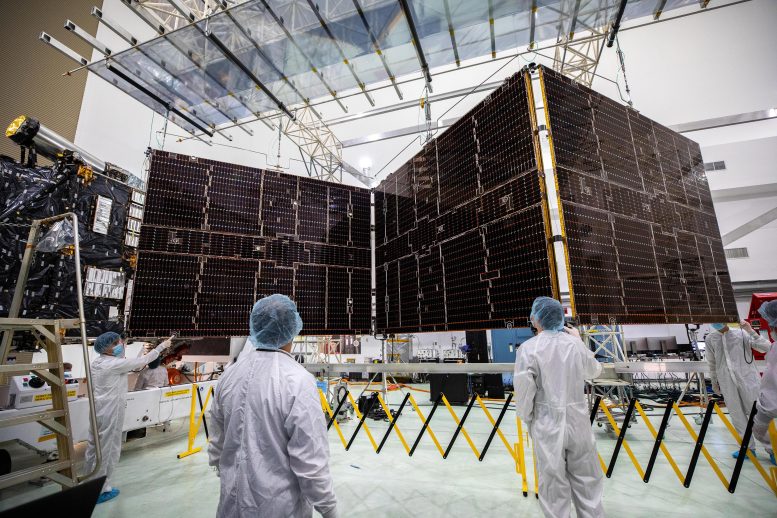
Technicians begin to retract one of the two solar arrays attached to NASA’s Psyche spacecraft. This photo was taken on July 25 inside the Astrotech Space Operations facility near the agency’s Kennedy Space Center in Florida. Credit: NASA/Kim Shiflett
The Psyche mission is speeding toward its October 5 launch date, preparing for the last of its launch-preparation milestones.
Robotically unfurling in a clean room near NASA’s Kennedy Space Center in Florida, the Psyche spacecraft’s jumbo solar arrays were tested and permanently installed on the orbiter in preparation for its 2.5 billion-mile (4 billion-kilometer) journey to study a metal-rich asteroid. The launch period opens on October 5.
Following a successful deployment test, the orbiter’s twin wings were re-stowed and will remain secured until the spacecraft departs Earth. Psyche is set to reach its destination – an enigmatic asteroid named Psyche, located in the main asteroid belt between Mars and Jupiter – in July 2029. Once there, the spacecraft will orbit the asteroid at varying altitudes for 26 months, capturing images and collecting other forms of data.
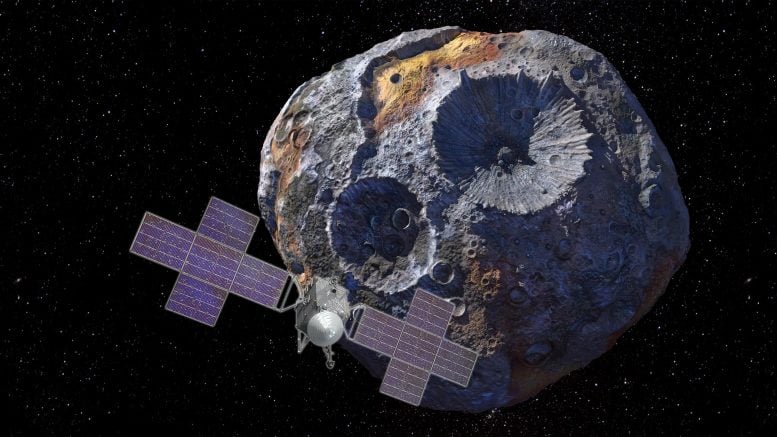
NASA’s Psyche mission to a distant metal asteroid will carry a revolutionary Deep Space Optical Communications (DSOC) package. Credit: NASA/JPL-Caltech/ASU
Planetary Insight Through Psyche
Scientists believe that studying the asteroid, which may be part of a core of a planetesimal (a building block of a planet), will tell us more about planetary cores and Earth’s own formation.
This final installation of the solar arrays took place at Astrotech Space Operations, near Kennedy. The arrays were deployed during testing last year at NASA’s Jet Propulsion Laboratory in Southern California. At 800 square feet (75 square meters), the five-panel, cross-shaped solar arrays are the largest ever deployed at JPL. With the arrays unfurled in flight, the spacecraft will be about the size of a singles tennis court.
The solar arrays for NASA’s Psyche mission underwent a final deployment test and were permanently installed on the spacecraft at Astrotech Space Operations near the agency’s Kennedy Space Center in Florida. Credit: NASA/Glenn Benson and Cory Huston
Powering the Journey
Although they will produce more than 20 kilowatts of power when the spacecraft is near Earth, the solar arrays are primarily designed to work in the low light of deep space. The asteroid Psyche is so far from the Sun that even these massive arrays will generate just over 2 kilowatts of power at that distance.
That’s only a little more power than a hair dryer uses but is ample energy to meet Psyche’s electrical needs, including running science instruments, telecommunications, equipment that controls the orbiter’s temperature, and the spacecraft’s superefficient solar electric propulsion engines. The system’s thrusters use electromagnetic fields to accelerate and push out charged atoms, or ions, of the neutral gas xenon. The expelled ions create the thrust that pushes Psyche through space and emit a blue glow.
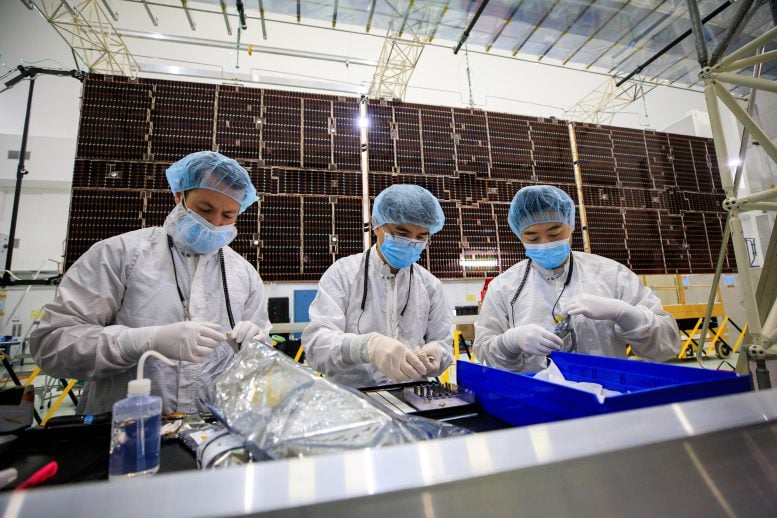
Team members prepare to integrate one of two solar arrays on NASA’s Psyche spacecraft, inside the Astrotech Space Operations facility near the agency’s Kennedy Space Center in Florida on July 24. Credit: NASA/Kim Shiflett
Thrust and Xenon Loading
This thrust is so gentle, it exerts about the same amount of pressure you’d feel holding the weight of one AA battery in your hand. But it’s enough to accelerate Psyche through deep space. With no atmospheric drag to hold it back, the spacecraft will accelerate to speeds of up to 124,000 mph (200,000 kph) relative to Earth during its interplanetary journey to the asteroid belt.
In mid-August, a crew is scheduled to begin loading all 2,392 pounds (1,085 kilograms) of xenon onto the spacecraft over the course of a couple of weeks.
The Launch Plan
A SpaceX Falcon Heavy is targeted to launch Psyche from Launch Complex 39A at Kennedy Space Center no earlier than 10:38 a.m. EDT (7:38 a.m. PDT) on October 5, with additional opportunities scheduled through October 25.
More About the Mission
Arizona State University spearheads the Psyche mission, while a division of Caltech in Pasadena, JPL, handles the mission’s overall management, system engineering, integration, test, and mission operations. Maxar Technologies in Palo Alto, California, provided the high-power solar electric propulsion spacecraft chassis.
JPL is also supplying a technology demonstration instrument, Deep Space Optical Communications, to test high-data-rate laser communications potentially used by future NASA missions.
The Psyche mission is the 14th selected as part of NASA’s Discovery Program, managed by the agency’s Marshall Space Flight Center in Huntsville, Alabama. The Kennedy Space Center-based Launch Services Program is overseeing the launch service.


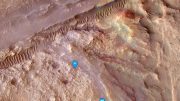
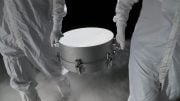
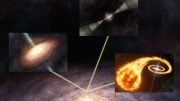


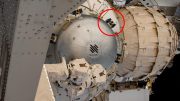

Be the first to comment on "NASA’s Journey to Psyche: The Power Behind the 2.5 Billion-Mile Mission"